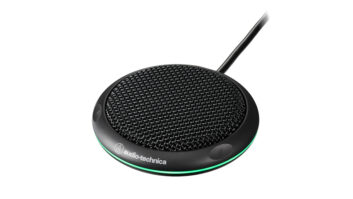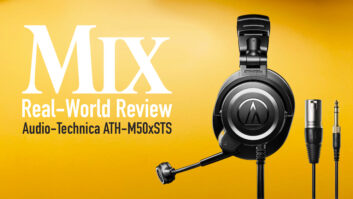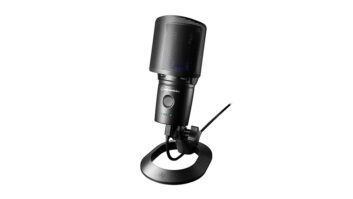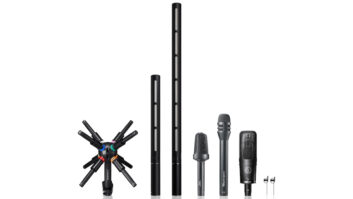Audio-Technica’s U100 UHF wireless mic systems come in two flavors: the ATW-U101 bodypack ($1,049) and the ATW-U102 XLR plug-on ($1,099). Both include the ATW-R100, a true diversity receiver, with two antennae feeding two completely independent RF sections set to the same frequency. A logic circuit continually compares the two signals and takes the best. A helical filter in the front end increases the rejection of unwanted signals.
Each transmitter and receiver can be user-adjusted (with a small “tweak stick”) to operate on 100 different frequencies (728.125-740.500 MHz) across UHF channels 57, 58 and a portion of 59. The FM deviation is 10 kHz. Frequency response is 100-15k Hz. The A-T circuitry depends on companding (compression and expanding) to keep background noise out of the input signal. You may hear a slight “rush” from the compander if the mic is in a quiet recording studio, but on the street or in a normally noisy location, the noise gets covered by the ambient noise level.
A quick look at the U100 manual makes it obvious that, even though there are 100 frequencies to choose from, there are limitations. “You can set up as many as 12 mics if there are no interfering TV channels in your area on channels 57, 58 and 59,” explains A-T’s Chuck Kraft. “You can choose from group A or Group B, but you can’t mix and match. You need that much space between operating frequencies to keep third-order interference from causing problems. If you have a DTV signal in the area you can’t operate a wireless on any of the frequencies within that 6 MHz.”
WIRELESS MICS VS. DIGITAL TV
Local WBAL-DT had recently fired up its DTV transmitter to 50% power on UHF channel 59. I took this opportunity to see what damage the DTV signal caused to the U100 system. Outside, the bodypack range went from about 200 feet to about 12 feet. Indoors, I got about 30 feet at ground level and a few feet farther in the basement. I also noticed that I was able to use the one frequency at the low end of UHF channel 59 (740.00-740.125 MHz) without any interference. The DTV on the other four frequencies on that channel sounded like white noise and/or radio telemetry. Fortunately the U100 had 96 more frequencies to choose from, so I selected another frequency and continued working.
The ATW-T101 bodypack transmitter uses a standard TB5M mic connector, the same connector used on many Lectrosonics body mics. I headed over to Hocus Focus Video Productions to put the A-T systems through their paces. Don Armstrong, president and main shooter, pulled out a Lectrosonic 185 and a Sony ECM-77 for comparison. The Sony ECM-77 with TB5M connector used with the Lectrosonics mated well with the ATW-T101 bodypack transmitter. I did have some problems disengaging the ECM-77 from the A-T bodypack transmitter. Close inspection revealed that the spring locking part of the plug was slightly different from those on the A-T mics and perhaps worn over time. I subsequently learned that this happens with a small percentage of these connectors.
The Sony ECM-77 sounded a bit edgy through the Lectrosonic system and clearer and cleaner through the Audio-Technica system. Armstrong noted that although the ECM-77 did sound a little rough at the receiver and the camera, it cut well in editing. We did a distance test, comparing the 100mW Lectrosonics and 50mW ATW-T101 bodypacks. Indoors through walls, I was able to get out of the office and down the hall about 40 feet before the A-T began to cut out and mute. The Lectrosonics lasted about another ten feet before it began to break up.
Outside, in unobstructed suburbia with new 9-volt batteries, I got a maximum of 90 yards with the ATW-T101 bodypack, as long as I had a clear shot. When I got in between the transmitter and receiver, with the bodypack hung off my waistband, or if I turned around with the plug-on mic, the range dropped to 70 yards for the body mic and about 40 yards for the plug-on transmitter.
In another test, I put the ATW-T102 plug-on transmitter to work with a Beyer M160 ribbon mic for the main vocal mic at a vocal/organ recital. The transmitter with its threaded cinch attached easily to the Beyer M160 and held the two firmly together. The ATW-T102 made the 40-to-50-foot trip to the receiver with no problems. It’s notable that both transmitters have a mic level adjustment that adjusts for the sensitivity of different mics. The Beyer M160 has a very low output. Even so, the ATW-T102 had enough gain to make it work very nicely.
Both transmitters are designed to deliver a 5VDC bias voltage, not enough to power a mic requiring 12 or 48 volts but enough to power an electret condenser like the Audio-Technica AT835b, AT815b shotguns, ATM10a omni, ATM31a cardioid oval or the ATM33a cardioid stick.
PICKING NITS
I couldn’t find a lot wrong with the units, but I’ll mention a few minor points. Audio-Technica provides a tiny plastic screwdriver for frequency changes. I really tried to keep track of it, but I lost it and found it three weeks later while vacuuming my dining room rug.
The LEDs on the receiver are difficult to read in sunlight. The arrowed tuning slots are also a bit difficult to see without a lot of light. I was also “tricked” by the system at first, because while the frequency selectors are the same on the plug-on transmitter and the receiver, the one on the bodypack is flipped around. The battery/control door on the bodypack mic is a little light in gauge and might be bent under panic conditions.
On the positive side, I like the fact that the battery/control door opens easily and that the belt clip on the bodypack transmitter swivels. I also like the separate headphone output and volume control on the receiver unit, which is separate from the receiver output control. Having 100 frequencies to chose from is also a plus. Just make sure that you have clear use of TV channels 57, 58 and 59.
CONCLUSIONS
Although the original target market for the U100 was the prosumer market and as third-tier network backup systems, local affiliates have found favor with them. The U100 is also compatible with the Audio-Technica 7000 series wireless systems. Both bodypack and plug-on offer reasonable performance with good-quality audio, at a price lower than expected. If you’re looking to go wireless, track these down for a trial.
Audio-Technica U.S., 1221 Commerce Drive, Stow, OH 44224; 330/ 686-2600; fax 330/686-0719; www. audio-technica.com.
Reach Ty Ford at www.tyford.com.






